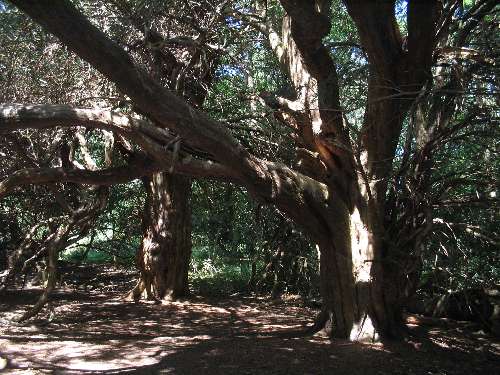 Cass Sculpture Foundation
Cass Sculpture Foundation Chichester Cathedral
Chichester Cathedral Chichester Harbour Water Tours
Chichester Harbour Water Tours Earnley Butterflies and Gardens
Earnley Butterflies and Gardens Fishbourne Roman Palace
Fishbourne Roman Palace Kingley Vale National Nature Reserve
Kingley Vale National Nature Reserve Mechanical Music and Doll Collection
Mechanical Music and Doll Collection Sussex Falconry Centre
Sussex Falconry Centre Tangmere Military Aviation Museum
Tangmere Military Aviation Museum The Novium Museum
The Novium Museum Weald and Downland Open Air Museum
Weald and Downland Open Air Museum West Dean Gardens
West Dean Gardens
Kingley Vale National Nature Reserve contains one of the finest yew forests in western Europe, including a grove of ancient trees which are among the oldest living things in Britain.
The thin soils on the steep valley slopes support a rich downland turf with up to 50 species of flowering plants and grasses within a square metre.
Kingley Vale National Nature Reserve is one of the most important archaeological sites in southern England and has 14 scheduled ancient monuments, including Bronze Age burial mounds at the top of Bow Hill. From here, there are stunning panoramic views.
Highlights: Of the 58 species of butterfly that breed in England, 39 have been recorded at Kingley Vale. Breeding birds have included nightingale, grasshopper warbler, blackcap, marsh tit and green woodpecker, though the first two of these are now only occasionally seen. The plaintive mewing of buzzards is sometimes heard over the reserve. This species has certainly become more frequently encountered over the last 10 years. Other birds of prey to be observed are kestrel, sparrowhawk, hobby (in summer) and tawny owl. Of the mammals, the most significant in terms of their effect on the reserve's vegetation are rabbits and the herds of roe and fallow deer. Their grazing and browsing help to restrict invading tall grasses and scrub.
On the negative side, the deer chew the bark of young yew trees and check their growth. Among other mammals found here are stoats, weasels, foxes, dormice and badgers.
Kingley Vale National Nature Reserve woods contain many other shrub and tree species, including ash, privet, blackthorn, hawthorn, dogwood and holly. Their berries and seeds provide food for winter flocks of thrushes - among which are visitors from mainland Europe like redwings and fieldfares - and for small mammals. Yew leaves and seeds can be highly poisonous but birds and shrews can eat the pulpy red fruits without ill effect. Location: The NNR is 5 km north west of Chichester. To reach the reserve by car, leave the A286 at Mid Lavant and continue west, to the NNR car park near the village of West Stoke. The reserve is signposted from there and is about 15 minutes walk along a footpath leading to the main entrance. Here, there is a small information centre with permanent displays and more information about the reserve.
There is easy access to the NNR from the car park to the visitor centre, but not beyond this, where the terrain is more difficult.
No Comments Yet - Why not be the first to leave a comment
Every effort is made to make sure that all the information is correct but we strongly recommend that you call Kingley Vale National Nature Reserve before you set off on your day out to confirm opening times and admission prices.
Please also note that the position on Google maps for Kingley Vale National Nature Reserve is a rough estimate using their postcode in the database and might be slightly out.
It may also be worth clicking the web link for Kingley Vale National Nature Reserve to see if there are any special events coming up or currently on.